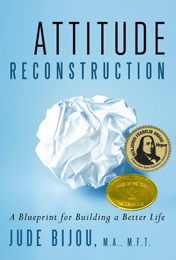By Jude Bijou, MA, MFT
Each of us was born with an emotional constitution that determines how we’re more likely to react in any situation. We all have a mix of three emotions – sadness, anger, and fear — but usually one or two of them governs our feelings, thoughts, words, and actions.
People whose most dominant emotion is sadness are easy to recognize. In general, they move more slowly than the rest of us, getting things done in their own sweet time. They have a tendency to be passive, and lack motivation. Wanting to be taken care of by others, sad folks usually are dependent on others for approval. Feeling fundamentally unworthy, unlovable, and small, they suffer from low self-esteem. They are easy to spot, because you’ll usually find them quietly hanging around in the background.
If you resonate with some of these tendencies and are tired of them, there are simple things you can do to change. First and foremost, increase the amount of stimulation you expose yourself to. That might sound easier said than done, as there’s so much inertial pulling you horizontal.
Here are five easy tips that will help you get moving, decrease the amount of sadness you feel, and increase the joy:
1. Mobilize more.
Even though it can feel monumental at first, seek new experiences. Seek positive and interactive entertainment to contradict the inertia. Reach out to others, and do activities you enjoy together. Strive to get regular aerobic exercise (or any exercise for that matter). Take little steps. If you try to do too much, you’ll set yourself up for a backlash.
2. Interrupt that constant mental chatter that tells you how terrible, small, unworthy, inadequate or unlovable you are, and remind yourself what you know when you’re centered and clear.
Many times a day repeat whichever of the following phrases most contradicts your old thinking or make one up along these lines: “I’m whole and complete. My job is to take care of myself. Life is for learning. We all make mistakes. I am responsible for what I feel, think, say, and do. I love myself. I love me.”
3. Allow yourself to cry when you feel sad, but while doing so refrain from trashing or feeling sorry for yourself.
If you already allow yourself to cry, that’s great. If you don’t, give yourself permission to. Crying is good. It’s natural. It’s healthy, especially as a reaction to hurts and losses. So ignore external pressures that tell you to hold it in, and go ahead and cry. However, while you do, it’s imperative that you don’t indulge your “poor me… I’m no good” thinking. Just allow yourself to cry while telling yourself, “I feel sad. It’s okay. I just need to cry.”
4. Speak up more often about what is true for you.
Instead of focusing on what you think others want, need, or believe, ask yourself: “What’s true for me?” After you listen within and discover what’s true for you, speak it out and translate it into action. It can feel foreign at first to consult yourself for guidance (much less speak up), but as you do, you’ll find that you feel more energetic, powerful, and confident.
5. In terms of lifestyle choices, stay warm and dry especially on damp, rainy, and cold days.
Don’t overeat – or at least try to minimize large heavy meals, especially in the evening. Avoid oily foods, such as nuts and fried foods, reduce dairy products, and strive to eliminate sweets.
If you implement these simple suggestions, just a tiny bit each day, you can make serious progress towards reducing feeling so blue, down, little, and sad. Instead, much to your amazement, you just might find yourself feeling more joy.






